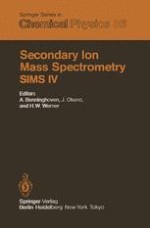1984 | OriginalPaper | Chapter
Cesium Ion Liquid Matrix Secondary Ion Mass Spectrometry and Its Impact on the Characterization of Free Labile Biological Substances
Author : A. L. Burlingame
Published in: Secondary Ion Mass Spectrometry SIMS IV
Publisher: Springer Berlin Heidelberg
Included in: Professional Book Archive
Activate our intelligent search to find suitable subject content or patents.
Select sections of text to find matching patents with Artificial Intelligence. powered by
Select sections of text to find additional relevant content using AI-assisted search. powered by
The early foundations of organic mass spectrometry evolved with the requirement and constraint that the sample or a suitable chemical derivative thereof be volatilized without thermal degradation prior to ionization and internal energy deposition into either the ambient ion source chamber vacuum or the injection port of a gas chromatograph/mass spectrometer, both usually held in the order of 200 + 50°. However, in this past decade, the inventions of new types of ion sources and techniques which obviate the requirement of sample volatilization prior to ionization per se have been occurring at a seemingly accelerating pace since the description of the first breakthrough in 1969 (viz., field desorption) and subsequently plasma desorption, laser desorption, secondary ion and thermospray techniques [1]. The steady successes, particularly using the techniques of field desorption and plasma desorption, have made sustained pioneering contributions in the characterization of previously intractable polar and labile biological substances and have set the stage for intimate mass spectrometric participation in studies of higher molecular weight biological and synthetic polymeric substances [2, 3]. Judging from the sometimes similar nature of the mass spectra observed, all of these new ionization/“desorption” techniques have attributes in common. However, their diversity (including their associated instruments’ ion optical properties, detectors, and computers) has quickly led to the ability to analyze directly the majority of compound types previously inaccessible by mass spectrometric techniques, including the polyfunctional polar, chemically and/or thermally labile biological substances, their salts, organometallic complexes, modified biopolymers, etc. [1, 2].
